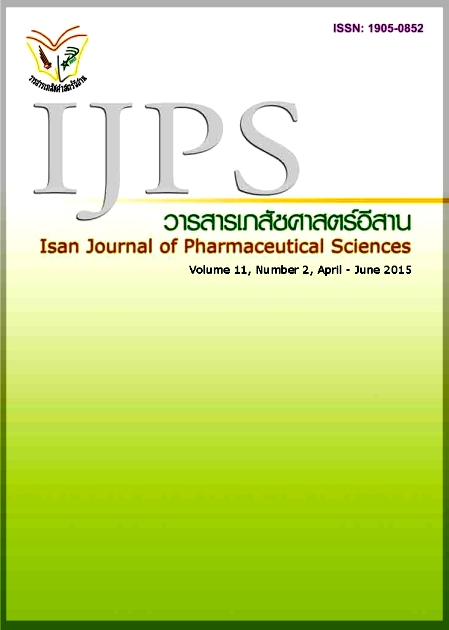เทคนิคไมโครนีเดิลส์สำหรับการนำส่งดีเอ็นเอผ่านทางผิวหนัง
Main Article Content
บทคัดย่อ
การรักษาด้วยยีนบำบัดในปัจจุบันได้รับความสนใจอย่างกว้างขวางในวงการแพทย์ยีนบำบัดอาศัยหลักการการนำส่งดีเอ็นเอที่มีฤทธิ์ในการรักษาเข้าสู่เซลล์และเนื้อเยื่อเพื่อให้ออกฤทธิ์ตามต้องการ ได้มีการใช้พลาสมิดดีเอ็นเอรักษาโรคทางผิวหนังโดยมีการทดสอบและพัฒนาทางคลินิกสำหรับโรคผิวหนังที่มีความผิดปกติทางพันธุกรรม เช่น โรคมะเร็งผิวหนัง โรคสะเก็ดเงิน และภาวะปลายประสาทอักเสบในผู้ป่วยโรคเบาหวาน เป็นต้น นอกจากนี้ยังมีการพัฒนาวัคซีนรูปแบบใหม่โดยใช้ดีเอ็นเอวัคซีนซึ่งเป็นเทคโนโลยีใหม่ที่น่าสนใจเนื่องจากมีข้อได้เปรียบที่เหนือกว่าวัคซีนแบบดั้งเดิมหลายประการ ผิวหนังเป็นอวัยวะที่มีความเหมาะสมสำหรับการนำส่งวัคซีนเนื่องจากเป็นเป้าหมายที่มีความหนาแน่นของเซลล์ที่สามารถนำเสนอแอนติเจนเพื่อให้เกิดการกระตุ้นภูมิคุ้มกันในปริมาณมาก ซึ่งได้แก่ เซลล์แลงเกอร์ฮาน (Langerhans cells) ในชั้นอิพิเดอร์มิสและเซลล์เดนไดรติก (dendritic cells) ในชั้นเดอร์มิส การนำส่งยาทางผิวหนังเป็นทางเลือกหนึ่งในการบริหารยาเข้าสู่ร่างกายที่มีข้อได้เปรียบมากมายและยังเหมาะสำหรับการฉีดวัคซีนเพื่อประยุกต์ในการป้องกันโรค อย่างไรก็ตามผิวหนังชั้นสตราตัมคอร์เนียมซึ่งเป็นผิวหนังชั้นนอกสุดที่ทำหน้าที่ป้องกันการซึมผ่านของสารเป็นข้อจำกัดในการนำส่งโมเลกุลยาเข้าสู่ผิวหนังโดยเฉพาะอย่างยิ่งสารที่มีโมเลกุลขนาดใหญ่และสารพันธุกรรมไม่สามารถนำส่งได้ในปริมาณที่มากเพียงพอต่อการออกฤทธิ์จึงได้มีการพัฒนาไมโครนีเดิลส์เพื่อใช้แทงผ่านผิวหนังชั้นสตราตัมคอร์เนียม สำหรับเพิ่มประสิทธิภาพในการนำส่งสารผ่านผิวหนัง ไมโครนีเดิลส์มีลักษณะคล้ายเข็มที่มีขนาดเส้นผ่านศูนย์กลางในระดับไมโครเมตร ข้อดีของไมโครนีเดิลส์ ได้แก่ ความสามารถในการแทงผ่านผิวหนังโดยทำความเสียหายต่อผิวหนังน้อยที่สุด ไม่ทำให้เจ็บปวด ใช้งานง่าย สามารถผลิตได้ในปริมาณมาก และมีราคาไม่แพงในบทความนี้ได้สรุปข้อมูลพื้นฐานโดยย่อและยกตัวอย่างการศึกษาวิจัยไมโครนีเดิลส์สำหรับใช้นำส่งดีเอ็นเอผ่านทางผิวหนัง ใช้ในการรักษาโรคทางพันธุกรรม และเป็นวัคซีน
Article Details
กรณีที่ใช้บางส่วนจากผลงานของผู้อื่น ผู้นิพนธ์ต้อง ยืนยันว่าได้รับการอนุญาต (permission) ให้ใช้ผลงานบางส่วนจากผู้นิพนธ์ต้นฉบับ (Original author) เรียบร้อยแล้ว และต้องแนบเอกสารหลักฐาน ว่าได้รับการอนุญาต (permission) ประกอบมาด้วย
References
Alzheimer’s association. Basics of alzheimer’s disease [pamphlet]. Alzheimer’s association; 2013.
Barry ME, Gonzalez DP, Orson FM, Mckenzie GJ, Petry GR, Barry MA. Role of Endogenous Endonucleases and Tissue Site in Transfection and CpG-Mediated Immune Activation after Naked DNA Injection. Hum Gene Ther 2004;10(15): 2461-80.
Cattamanchi A, Posavad CM, Wald A, Baine Y, Moses J, Higgins TJ, et al. Phase I Study of a Herpes Simplex Virus Type 2 (HSV-2) DNA Vaccine Administered to Healthy, HSV-2-Seronegative Adults by a Needle-Free Injection System. Clin Vaccine Immunol 2008;15(11):1638-43.
Chen X, Kask AS, Crichton ML, McNeilly C, Yukiko S, Dong L, et al. Improved DNA vaccination by skin-targeted delivery using dry-coated densely-packed microprojection arrays. J Control Release 2010;148(3):327-33.
CalladineCR, Drew H, Luisi B, Travers A. Understanding DNA: The Molecule and How it Works. San Diego: Elsevier Academic Press; 2004.
Donnelly JJ, Wahren B, Liu MA. DNA Vaccines: Progress and Challenges. J Immunol 2005;175(2):633-9.
Ferraro B, Morrow MP, Hutnick NA, Shin TH, Lucke CE, Weiner DB. Clinical Applications of DNA Vaccines: Current Progress. Clin Infect Dis 2011;53(3):296-302.
Fitzgerald-Hayes M, Frieda R. DNA and biotechnology. Burlington: Elsevier Academic Press; 2010.
Gill HS, Prausnitz MR. Coated microneedles for transdermal delivery. J Control Release 2007;117(2): 227-237.
Haq MI, Smith E, John DN, Kalavala M, Edwards C, Anstey A, et al. Clinical administration of microneedles: skin puncture, pain and sensation. Biomed Microdevices 2009; 11(1):35-47.
Ibraheem D, Elaissari A, Fessi H. Gene therapy and DNA delivery systems. Int J Pharm 2014;459(1–2):70-83.
Indermun S, Luttge R, Choonara YE, Kumar P, du Toit LC, Modi G, et al. Current advances in the fabrication of microneedles for transdermal delivery. J Control Release 2014;185(0):130-8.
Jhawat VC, Saini V, Kamboj S, Maggon N. Transdermal Drug Delivery Systems: Approaches and Advancements in Drug Absorption through Skin. Int J Pharm Sci Rev Res 2013;20(1): 47-56
Kendall M. Demo: A needle-free vaccine patch that’s safer and way cheaper. [Video fi le]. 2013Jun [cited 2014Nov2];Available from:URL:http://www.ted.com/talks/mark_kendall_demo_a_needle_free_vaccine_patch_that_s_safer_and_way_cheaper#
Kim NW, Lee MS, Kim KR, Lee JE, Lee K, Park JS, et al. Polyplex-releasing microneedles for enhanced cutaneous delivery of DNA vaccine. J Control Releas 2014; 179(0):11-7.
Kim Y-C, Park JH, Prausnitz MR. Microneedles for drug and vaccine delivery. Adv Drug Deliver Rev 2012a;64(14):1547-68.
Kim Y-C, Song JM, Lipatov AS, Choi SO, Lee JW, Donis RO, et al. Increased immunogenicity of avian infl uenza DNA vaccine delivered to the skin using a microneedle patch. Eur J Pharm Biopharm 2012b; 81(2): 239-247.
Kim Y-C, Suh H, Shin J. Microneedle patches for vaccine delivery. Clin Exp Vaccine Res 2014;3(1):42-9.
Koprowski H, Weiner DB. DNA Vaccination/Genetic Vaccination.Berlin: Springer; 1998.
Kumar A, Wonganan P, Sandoval MA, Li X, Zhu S, Cui Z. Microneedle-mediated transcutaneous immunization with plasmid DNA coated on cationic PLGA nanoparticles. J Control Release 2012;163(2):230-9.
Li L, Saade F, Petrovsky N. The future of human DNA vaccines. J Biotechnol 2012;162 (2-3):171-82.
Liu MA. DNA vaccines: a review. J Int Med 2003;253(4):402-10.
MacLaughlinF, Rolland A. Pharmaceutical Gene Delivery Systems. In: Rolland A, Sullivan SM, ditors.Device-Mediated Gene Delivery: A Review. United States of America: CRC Press; 2003. p. 245-77.
McCrudden MTC, McAlister E, Courtenay AJ, González-Vázquez P, Singh TRR, Donnelly RF. Microneedle applications in improving skin appearance. Exp Dermatol 2015 (in press).
Naik A, Kalia YN, Guy RH. Transdermal drug delivery: overcoming the skin’s barrier function. Pharm Sci Technal To 2000; 3(9):318-26.
Pereira VB, Zurita-Turk M, Saraiva TDL, De Castro CP, Souza BM, Agresti PM et al. DNA Vaccines Approach: From Concepts to Applications. World J Vaccine 2014; 4(2):50-71.
Schleef M. DNA Pharmaceuticals: Formulation and Delivery in Gene Therapy, DNA Vaccination and Immunotherapy. Germany: The Federal Republiic of Germany; 2005.
Shedlock DJ, Weiner DB. DNA vaccination: antigen presentation and the induction of immunity. J Leukoc Biol 2000;68(6): 793-806.
Sparber F, Tripp CH, Hermann M, Romani N, Stoitzner P. Langerhans cells and dermal dendritic cells capture protein antigens in the skin: Possible targets for vaccination through the skin. Immunobiology 2010;215(9–10):770-9.
Tuan-Mahmood TM, McCrudden MTC, Torrisi BM, McAlister E, Garland MJ, Singh TRR, et al. Microneedles for intradermal and transdermal drug delivery. Eur J Pharm Sci 2013;50(5):623-37.
van der Maaden K, Jiskoot W, Bouwstra J. Microneedle technologies for (trans)dermal drug and vaccine delivery. J Control Release 2012;161(2):645-55.
van der Maaden K, Sekerdag E, Jiskoot W, Bouwstra J. Impact-Insertion Applicator Improves Reliability of Skin Penetration by Solid Microneedle Arrays. AAPS J 2014;16(4):681-4.
Walker R, Jones S. Genes & DNA. Boston, Kingfi sher; 2003.
Watson J. DNA : the secret of life. New York: Alfred A. Knopf; 2003.
World Health Organization. Influenza at the human-animal interface [pamphlet]. World Health Organization; 2013.
Yan G, Arelly N, Farhan N, Lobo S, Li H. Enhancing DNA delivery into the skin with a motorized microneedle device. Eur J Pharm Sci 2014;52:215-22.

